Maths Masters under the Scope
by Burkard Polster and Marty Ross
The Age, 6 September 2010
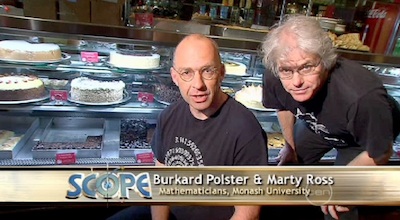
You might recall our shameless jumping on the MasterChef bandwagon, sharing some delicious mathematics recipes. This somehow resulted in a call from the producers at Scope, Channel Ten's science show for kids. They wanted us to do a segment for their special episode on mathematics. They didn't have to ask twice.
Scope's maths episode aired on August 28 and can be viewed here. Your maths masters are featured in the second segment: Lunch with the Mathematicians.
Though neither of us will win any acting awards, it was great fun, and we got to demonstrate some cool maths. However, the segment also moves very quickly. So, for those who prefer to savour their mathematical dishes, we offer here an annotated transcript:
(Burkard) Serious and high-powered mathematics. A lot of it is going on in the world. And so is fun and delicious maths, which is the kind we'll be doing today. Hi, I'm Burkard. (Marty) I'm Marty. (Burkard) We're mathematicians. (Marty) Quite hungry mathematicians. (Burkard) And we'd like you to join us for lunch.
(Marty) First on the menu is pizza, but it comes with a problem to solve. Burkard is giving me the choice of taking for myself either one large pizza or a medium plus a small one, and I want to choose the option which will give me the most pizza, but I don't know which one that is.... until I've done some fast maths to work it out.
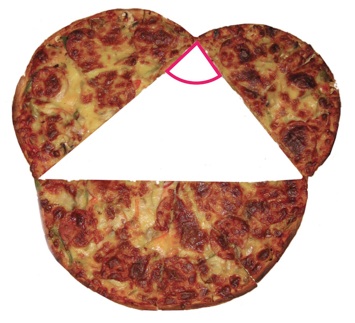
I cut each pizza in half and arrange the halves so their sides make a triangle. Then I look at the size of the angle between the triangle's small sides. If this angle is greater than a right angle, which is ninety degrees, then the large pizza is bigger than the other two combined. But it turns out that the angle is slightly smaller than a right angle, which means that the small and the medium pizza is my best bet. I'll take these two, Burkard.
The clue for why this works is "right angle". If instead we used square pizzas, and if a right angle is formed, then Pythagoras's Theorem ensures that the small-medium combo has the same amount of pizza as the large; and, an angle less than a right angle means that choosing the small-medium combo gives us more pizza. Our trick is based on the fact that Pythagoras's Theorem also works if we replace the squares along the edges by semicircles.
(Burkard) All right, after Marty is finished making the most of his smart pizza choice, I am going to present him with a drinks dilemma. I ordered some cordial and water so we could mix our drinks just how we like them. Strong for me, using 2/3 cordial and 1/3 water, and weaker for Marty: 1/3 cordial and 2/3 water.
Now, I'm going to ask Marty to mix the drinks we want, without using any other glasses or jugs. (Marty is scribbling on a napkin) Well, looks like he's on the right track. Marty pours half of the cordial into the water, and then pours the same amount of that mixture back into the cordial. And he ends up with two equally full glasses, both of them just what we were after.
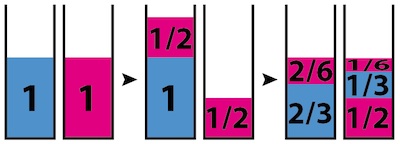
Above is an illustration of how the cordial and water combine. The result is Marty's preferred mixture on the left and Burkard's on the right.

(Marty) Okay, now let's get into some cake maths. What we want to do is to divide this (square!) cake between the five of us so we all get the same amount of cake, and the same amount of icing. Cutting the cake like this would give five equal-sized pieces, but some of them would have much more icing than the rest.
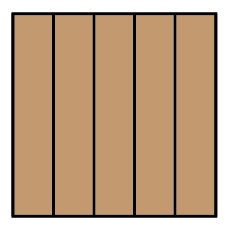
And, cutting the cake like a pizza, making all of the angles the same, will result in unevenly shared icing and cake. So, can maths help us out this time? Of course it can! And all we need is one simple tool. (Marty hands Burkard a ruler.)
Since the cake's edge, the perimeter, is iced we want to equally share it between the five pieces we cut. So, Burkard measures it (70 centimeters), and divides this figure by five. Then he uses his answer, which is 14 centimeters, to determine his equally spaced cutting points.
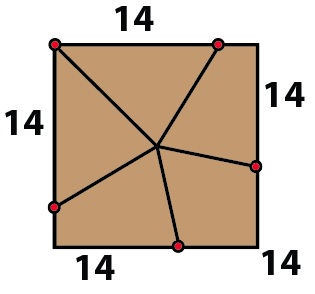
Slicing from these to the cake's center gives five pieces with equal amounts of cake and icing, which should keep even my most difficult friends happy.
The cuts are designed so that the icing around the edge is divided into five equal parts. However, it is trickier to see that the cake (and so also the icing on top) is also equally divided.
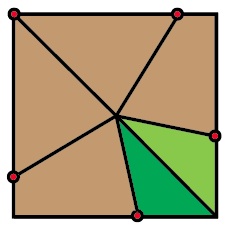
Each slice can be thought of as either one or two triangles with base along the edge of the square: for each slice, the total length of the base(s) is 14 centimeters. As well, all the triangles also have the same height (half the sidelength of the cake). So, the "half bases times height" formula for the area of a triangle guarantees that each slice consists of exactly the same amount of cake (and icing on top).
(Burkard) So, this is how maths can take the guesswork out of serving pizza, cordial,and cake. (Marty) Of course, it does work on healthy foods, too.
So, that was our mathematical lunch. And all of it packed into a mere three minutes of television. Phew!
Puzzle to Ponder: Feel free to suggest solutions in the comments section. Please also email us if you wish to be added to our email list.
Below is the napkin, showing Marty's pretend calculations. Can you spot some famous bits of mathematics (and our mascot, QEDcat)?
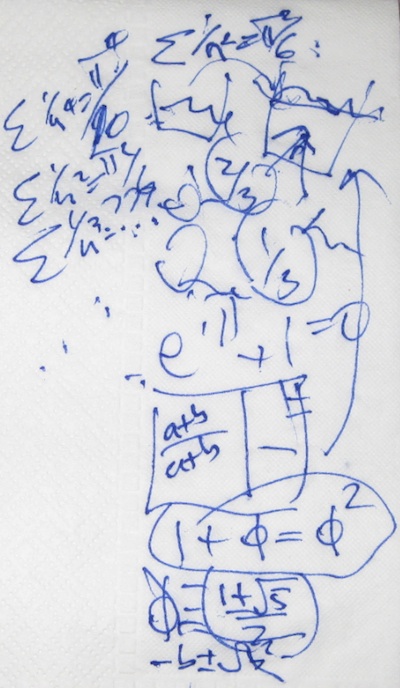
Burkard Polster teaches mathematics at Monash and is the university's resident mathemagician, mathematical juggler, origami expert, bubble-master, shoelace charmer, and Count von Count impersonator.
Marty Ross is a mathematical nomad. His hobby is smashing calculators with a hammer.
Free Public Lecture, Sunday September 12: Marty will give a talk entitled Mathematics and the Magic Box, Melbourne Museum, 11:30-12:30. For more information, please visit the MAV website.
Copyright 2004-∞ ![]() All rights reserved.
All rights reserved.